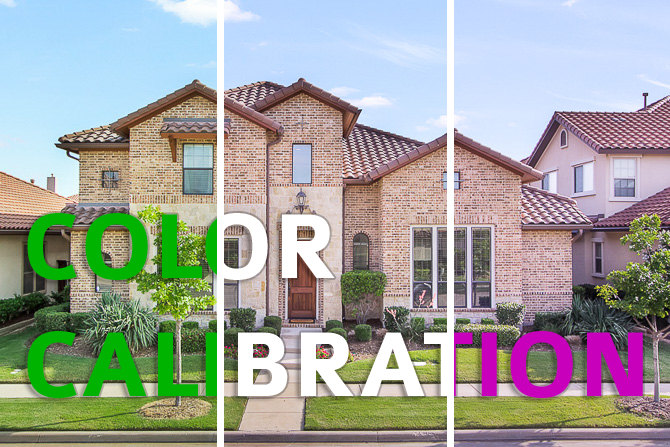It took me a couple of years of running my real estate photography business before I ran into a situation where I needed to color calibrate my monitor. All of the photos that I took were uploaded to MLS and viewed online, right? And everything can see the photos like I see them, we don’t have a printer getting in the way, so what’s the point of color calibration?
I couldn’t have been any more wrong! Although it took a couple of years for an issue to rise up, I failed to realize that agents were printing fliers and magazines using my photos. But it was a gig with a big retail furniture company that woke me up and made me realize the importance of knowing what my photos actually look like.
Scroll through the below three photos. You’ll probably notice a color difference between them all.
The Real Question
Which version above is “right”? In the past, I relied on my uncalibrated Dell monitor to tell me what color adjustments to make. But I got into a bit of a situation when a retail furniture store asked me to take photos of their showroom. They wanted to use the photos internally only for training materials.
After I delivered the photos to them, they wrote back saying the color was off. They said they had another photographer at another location deliver them photos that weren’t close to the color of mine. They wanted mine to match the other set.
At the end of the day, it doesn’t matter to me what the photos look like. They looked horrible according to me! But the client needed to be happy with the result, so I ended up adjusting the photos to get them closer to the samples they sent me that were taken by the other photographer.
Arm Yourself

With an uncalibrated monitor you are taking a shot in the dark just like your client. There are no hard facts to base your opinion on. At least with a calibrated monitor, you can try to explain to your client that you edit from a calibrated monitor and that making adjustments may not be the best way to go. Without calibration however, you don’t have much to stand on.
Datacolor Spyder4Pro S4P100
The calibrator that I use, and the only one I’ve had experience with, is the Datacolor Spyder4Pro (S4P100) (Amazon aff. link). It’s super easy to get up and running and you can use it on all of your monitors. I calibrate my MacBook Pro, my Mac desktop (that uses a Dell monitor), and my MacBook Air.
You simply install the software, then hang the calibrator over your monitor so it’s resting on your screen. It also comes with a stand so the calibrator can rest on your desk. It will measure ambient light and make adjustments on the fly if you would like.
I’ll be honest. The Mac products that I have don’t get much adjustment when hooked up to the Spyder. The monitors are simply calibrated really well from the get go. The Dell monitor however…now that’s a completely different story. The color changed drastically on that monitor after calibration. It really makes you sit back for a second and think “Wow…I was really editing on this all of this time.”
Benefits of Monitor Color Calibration
If you are like me, the majority of your work is handled digitally. You deliver photos to agents via the web, and never print anything yourself. You have to remember though that agents will print fliers for their properties. I also have a big producing team that prints a quarterly magazine so it’s even more important that I’m sharp with my color balance.
I’m also working on up-sell items right now to sell to Realtors. They are closing gifts for sellers and a great way for them to remember their home. It’s important that when I print the products, they look as intended and the colors on the prints match what I see on my screen.
Final Thoughts
We can’t control what others see and if they are or are not using a calibrated monitor. But we can be sure we start off on the right foot by having our equipment calibrated, so we are better able to handle situations when clients question the color of our real estate photos.




i realized this also just recently. i just purchased a new (pc) laptop and the default display colors are horrid. the grass is just shy of neon green. light blue is lavendar. too much contrast so detail is lost. i wanted to cry,
Yup Jackie, I’ve seen some laptops with very bad color as well. It’s pretty amazing the difference between displays and colors when you think about it!
Lance, how well does the spyder4Pro work when you have two completely different types of monitors?
Kansas City real estate photography
Side-by-side? I’m not sure. I use it on my MacBook Pro, and also a Dell Monitor that I use on my desktop. Both screens look great and photos look similar. Hopefully that answers your question? I normally use my MacBook Pro for photos, and my Desktop for Video…so I’m not usually using different PCs for the same purpose. If you were to set two monitors side-by-side to edit photos, I’m not sure how well the Spyder would work – but I would imagine it should make both colors match!
I currently have the Spyder4 express, which does not allow multiple display calibration. I have one laptop that I do everything on, and connect it to 1 or 2 external monitors. The reason I am looking to upgrade to possibly the pro or elite, is so that it will calibrate all monitors connected to my laptop, as well as my laptop monitor.
real estate photography Kansas City
Gotchya. With the Spyder4Pro, you shouldn’t have any problem adjusting multiple monitors. They list it here in the features:
Spyder4pro works with your laptop, multiple monitors, iPad, iPhone and Android devices. It works with LCD, LED, OLED, CRT, Retina Display, and other display technologies. You can calibrate multiple displays connected to your computer.
I’ve been taking photos of listing for a few years now and I’ve never even thought of this since we don’t use much print advertising. Gonna test out a calibrator now to see if I’m doing it right. Useful article, thank you.